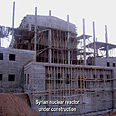
Syria denies graphite found at nuclear site
Damascus reported to be building missile facility on bombed site of alleged nuclear reactor; Syrian nuclear chief says IAEA's evidence of graphite traces doesn't prove site was nuclear
Diplomats say Syria has indicated it built a missile facility on the site of an alleged nuclear reactor that Israeli warplanes bombed. State representatives maintain that assessments by the International Atomic Energy Agency of probable nuclear matter at the cite are false.
The diplomats cited Ibrahim Othman, the head of Syria's Atomic Energy Commission, as telling a closed meeting of the IAEA about the facility, which appeared to be either a missile control center or an actual launching pad.
Ynet's security affairs analyst, Ron Ben-Yishai, estimates that such missiles are grade D scuds, based on the shape and height of the fledgling structure, as well as testimony by UN inspectors who had visited the area.
The range of such missiles is some 700 km, a problematic distance given that the site sits only 540 km from Israel's border with Syria at the Golan Heights. Missiles launched from the site would be able to strike central Israel.
According to Israel and the US, the site, known alternatively as Al-Kibar or Dair Alzour and which was bombed by Israel's Air Force in 2007, previously contained a nearly completed reactor that would have been able to produce plutonium.
Already last year, the IAEA had revealed that a "significant" number of particles of man-made uranium had been found.
A recent statement by the nuclear watchdog, who visited the site last June to test for nuclear chemicals, strengthened US claims because it showed that traces of graphite, a key element used in the core of nuclear reactors, had been found at the site.
And last week, a senior IAEA official revealed that even more unexplained uranium had been found, plus traces of graphite, even if it was too early to determine whether it was nuclear-grade graphite.
Syria: No graphite there
Despite IAEA findings, Othman, citing Syria's official stance, denied the existence of nuclear activity or capabilities. "There was no graphite (at the site) at all," he said. "There was ... no reason for graphite to be there."
"If the building was a nuclear reactor as they claim, then it would have contained a huge amount of graphite," he added. "And this bombardment would spread the graphite everywhere. It's not difficult to find graphite, if it was graphite ... They didn't find any."
"They found 80 particles in half a million tons of soil. I don't know how you can use that figure to accuse somebody of building such a facility," Othman insisted.
The substance inspectors found may simply have been carbon and that could have come "from anywhere, it could have come from cars," he added. Syria has also find excuses for the presence of the uranium, claiming that the traces came from Israeli missiles.
Uranium not from Israeli bombs
The IAEA dismissed Damascus's claims that the uranium could have come from the Israeli bombs, saying in its latest report that the IAEA's "current assessment is that there is a low probability that the uranium was introduced by the use of missiles.""The isotopic and chemical composition and the morphology of the particles are all inconsistent with what would be expected from the use of uranium based munitions."
Despite rejecting the IAEA's findings, Othman insisted that Syria would "continue cooperating with the agency, according to the statutes of the agency and according to the safeguards agreement that we signed with the agency."
But "we will not go beyond that," he added.
AP and AFP contributed to this report










